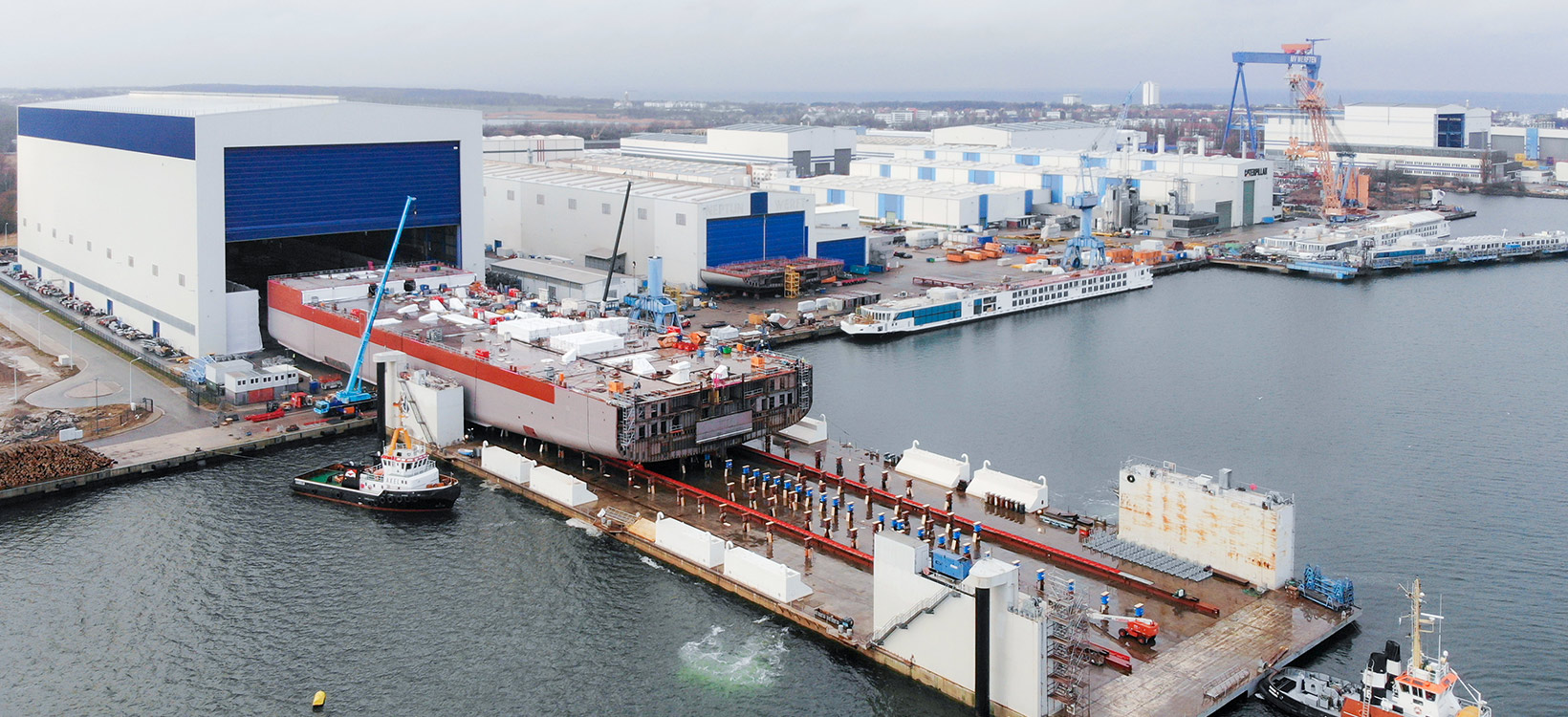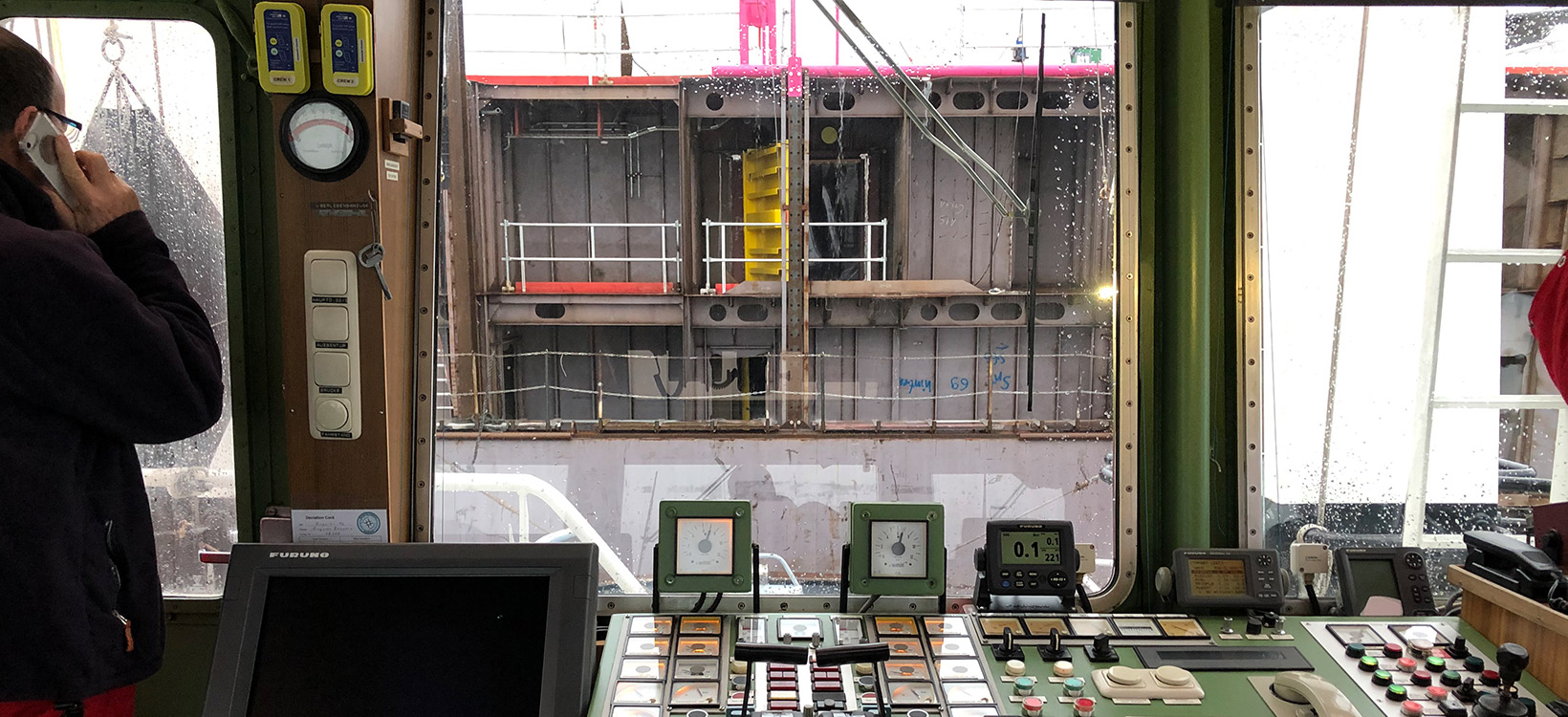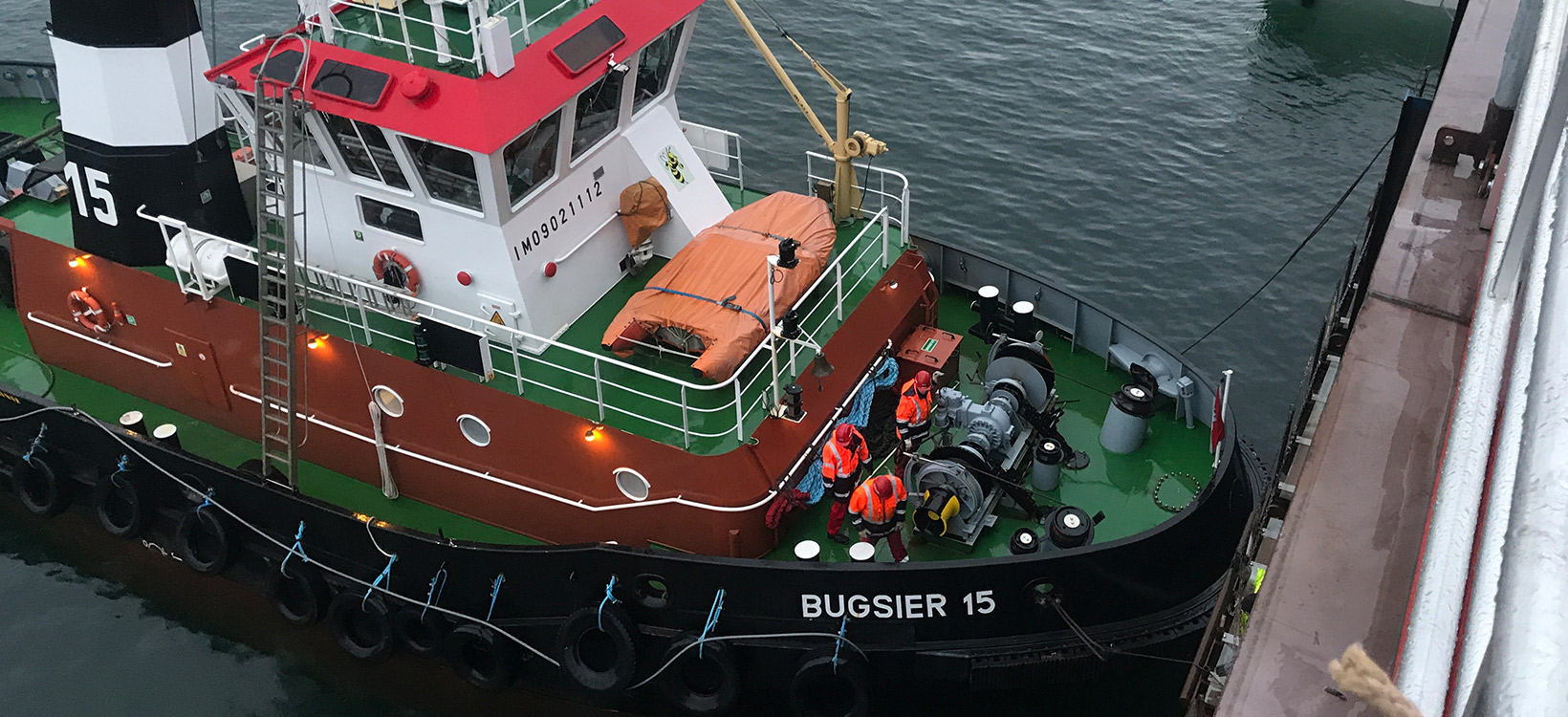Moving a camel through the eye of a needle with GNSS
Case study

Author: Beate Wesenigk
The NEPTUN shipyard is part of the MEYER Group based in Papenburg, Northern Germany, and enormous floating objects are constructed in it – Floating Engine Room Units (FERUs), the ‘power stations’ for giant cruise ships. Specialised in FERUs, this shipyard in northern Germany, faces a big challenge – FERUs are not constructed in dry docks, but in various production halls above the water line. To bridge the 2-metre height difference, a floating lowering system was developed. To manoeuvre FERUs safely out of the production halls and off the lowering systems, NEPTUN shipyard started using Leica Geosystems GNSS technology.
Blind trust as a prerequisite

The lowering system is a shippable floating dock. It consists of a reinforced concrete pontoon with additional superstructures on top. The float itself is 150 m long, 55 m wide and 7.5 m high. Inside the pontoon, there are water tanks. During docking, FERUs are fixated with the help of steel-cable winches. The lowering system has a dedicated control room located in the front tower on the starboard side. From there, all systems are monitored and controlled.
When it is ready to be transported off-site, a FERU is first lifted inside the production hall with the help of a hydraulic system. It is then slid across a silicone-coated path on land up to the quay wall where the lowering system is waiting in the water. When the ship is positioned on the lowering system, tug boats pull the gigantic FERU – that weighs more than 40,000 tons at this point – right above the 16-m deep docking pit. The lowering system must then be correctly positioned down to a couple of centimetres and secured in a way the only options for movement are up and down.
Subsequently, the tanks are flooded, thus sinking the entire lowering system. Ultimately, only 2 m of the 18-m superstructure protrudes above the water. As soon as there is enough water on the deck, the tug boat captains receive their go-ahead. The FERU is then moored at the bow and the stern.
This undocking process itself can be likened to the metaphor of a camel going through the eye of a needle describing a very narrow opening – the distance between the undocked ship and the superstructures is only 120 cm at its most. The tug boat captains and the pilot atop the FERU have no means of orienting themselves towards the port- or starboard side. The captain at the stern only sees metres upon metres of grey metal wall towering in front of him. Both captains need to blindly trust the pilot. This means the exact position of the FERU atop the lowering system must be known. Otherwise, avoiding collisions with the superstructures is impossible and these would inevitably damage the FERU as well as the lowering system.
Using GNSS technology for construction sites

A GNSS-supported measurement process with Leica Geosystems technologies is now used in all the steps. Multi-frequency GNSS antennae were installed on the starboard-side bow and stern of the superstructures on the lowering system. The accompanying dual GNSS receiver Leica iCG 80 is fitted in the control room. This installation, originally developed by Leica Geosystems to be used on heavy construction machinery in civil engineering, cannot only determine the exact position but also make predictions about potential movements. Subsequently, the relative position of the antennae in relation to the lowering system was determined with a one-time tachymetric measurement using a Leica Nova TS60 total station. In one of the shipyard's halls, a Leica Viva GS10 GNSS high-precision receiver was installed in a relatively sheltered spot, serving as a precise-measured fixed point.
FERU 1396, the first undocked power station with help of the new system, will be the centrepiece for one of the newest cruise ships for the largest cruise line in the world. Two iCG80 GNSS receivers were first installed at the previously measured locations on the lowering system and the receiver in the control room was activated. Using this installation, it was possible to move the FERU from the production hall onto an exact position on the lowering system. To undock the FERU from the lowering system, both antennae were installed on it.
The control software for the lowering system used in the control room links GNSS data, terrestrial and maritime maps, providing real-time data as well as forecasting data for the projected movements of the lowering system and the FERU to all participants in the undocking process. To react immediately to changes and give out appropriate instructions the pilots and tug boat captains use Leica CS35 field tablets. In addition to the real-time data and movement projections on their CS35 field tablet, the pilots and tug boat captains also see exactly how much they have to steer to starboard and port to leave the lowering system without damage.
Navigating FERU 1396 out of the eye of the needle took only 10 minutes – a time that would have been impossible for a safe undocking, especially at a day with winds of force six because, due to its dimensions, the FERU poses such a big target for the wind.
Faster + more flexible = more profits

The MEYER Group has been successfully using measurement solutions from Leica Geosystems for many years. During the conception phase, GNSS solutions from various suppliers were evaluated. The main criteria were:
- Positioning accuracy of 2 to 3 cm, even on moving ground
- Immunity to environmental factors, such as temperature fluctuations and salt water
- Wireless and radio-less data transfer.
The survey team headed by Ralph Zimmermann decided for the Leica Geosystems solution. The iCG80 GNSS receivers were developed to withstand harsh conditions on construction sites, work error-free from -20 C to + 40 C and are splash water resistant.
Lars Wegener and Kevin Schemmel, part of the survey team at NEPTUN shipyard, reported, “Relocation of 1396 went well.” Zimmermann expanded, “With the help of this technology, we have literally made big things happen. You could clearly see that we practise the motto of the MEYER Group, ‘Stronger together’, because, in addition to the workers of both shipyards, many specialists were involved; experts for nautical map technology, classical coastal navigation and tugging methods.”
This system benefits the MEYER Group in various ways for ongoing tasks as well as for future projects. The entire process of moving and undocking FERUs has become much safer because of the provided real-time positions, movement projections and calculations for tug control help to avoid collisions. Furthermore, it is possible to move and undock objects that extend beyond the bow and stern of the lowering system. The speed, precision and reliability of the system unaltered by weather conditions is a perfect fit for MEYER Group who plans to build three cruise ships in Papenburg starting in 2019 and, in the future, two per year in Turku, Finland.

























